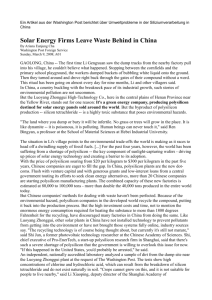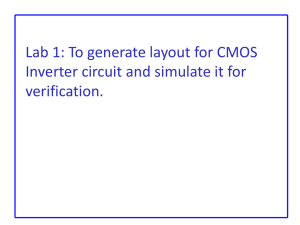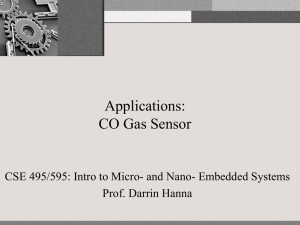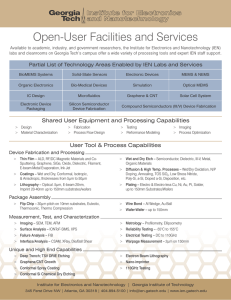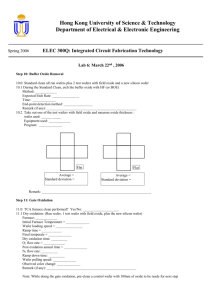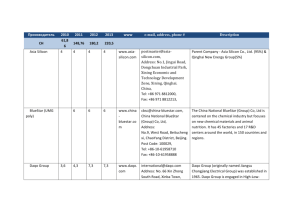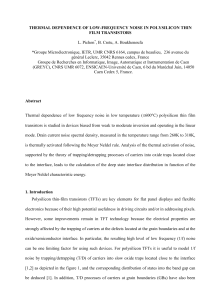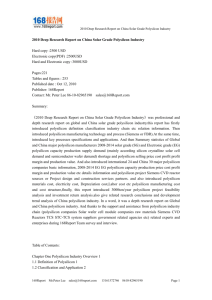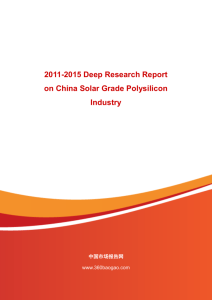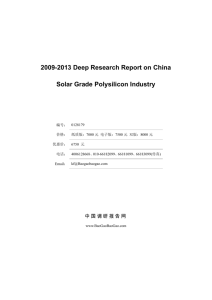Japan Polysilicon Market Outlook to 2018
advertisement
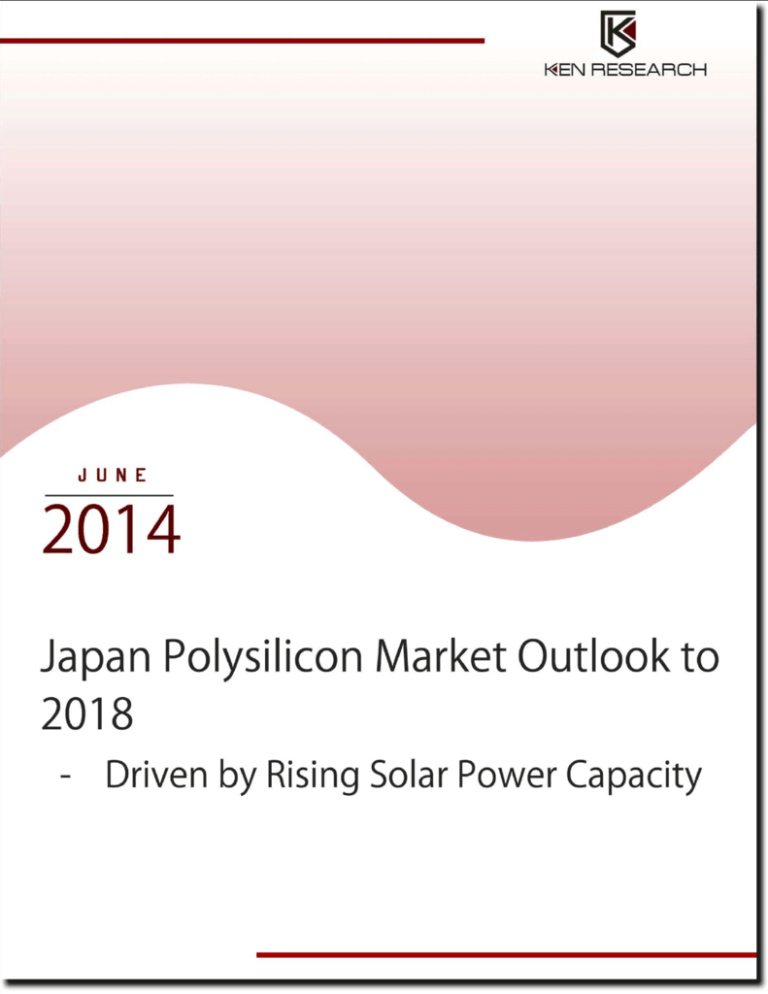
1 © This is a licensed product of Ken Research and should not be copied TABLE OF CONTENTS 1. Japan Polysilicon Industry Introduction 2. Japan Polysilicon Market Size 3. 2.1. By Production and Demand by Volume, 2008-2013 2.2. By Revenue, 2008-2013 Japan Polysilicon Market Segmentation 3.1. By Solar and Semiconductor Grade (Demand by Volume), 2013 3.2. By End User Industries (Production by Volume), 2011-2013 4. Trends and Developments in Japan Polysilicon Market 5. Growth Drivers of Japan Polysilicon Industry 6. Challenges of Japan Polysilicon Industry 7. Market Share of Major Companies in Japan Polysilicon Market, 2013 8. Company Profile of Major Players in Japan Polysilicon Industry 8.1. Tokuyama Corporation 8.1.1. Business Overview 8.1.2. Business Strategies 8.1.3. Key Performance Indicators 8.2. M. Setek Private Limited 8.2.1. Business Overview 8.2.2. Business Strategies 8.3. Osaka Titanium Technologies 8.3.1. Business Overview 8.3.2. Business Strategies 8.3.3. Key Performance Indicators 8.4. Mitsubishi Materials Corporation 8.4.1. Business Overview 8.4.2. Business Strategies 8.4.3. Key Performance Indicators 2 © This is a licensed product of Ken Research and should not be copied 9. Comparative Analysis of Japan Polysilicon Industry with Developed Economies 10. Government Initiatives and Regulations on Japan Polysilicon Industry 11. Japan Polysilicon Industry Future Outlook and Projections, 2014-2018 11.1. By Revenue, 2014-2018 11.2. By Production Volume, 2014-2018 11.3. Cause and Effect Relationship Between The Industry Factors and Polysilicon Market in Japan 12. Macroeconomic Variables 12.1. Photovoltaic Industry Size in Japan, 2008-2018 12.2. Solar Power Capacity in Japan, 2008-2018 12.3. Gross Domestic product of Japan 12.4. Policies and Trade Measures Implemented By Government of Japan 13. Appendix 13.1. Market Definitions 13.2. Abbreviations 13.3. Research Methodology Data Collection Methods Approach Variables (Dependent and Independent) Final Conclusion 13.4. Disclaimer 3 © This is a licensed product of Ken Research and should not be copied LIST OF FIGURES Figure 1: Global Polysilicon Market Size by Revenue in USD Million, 2008-2013 Figure 2: Global Polysilicon Production across Major Countries in the World in Percentage (%), 2012 Figure 3: Japan Polysilicon Market Size on the Basis of Production and Demand by Volume in Tons, 2008-2013 Figure 4: Japan Polysilicon Market Size on the Basis of Revenue in USD Million, 2008-2013 Figure 5: Japan Polysilicon Industry Market Segmentation by Different Types of Grades of Polysilicon on the Basis of Total Demand of Polysilicon in Japan in Percentage (%), 2013 Figure 6: Market Share of Major Companies in Japan Polysilicon Industry on the Basis of Total Production Volume in Percentage (%), 2013 Figure 7: Tokuyama Corporation Global Revenue in USD Million, 2008-2013 Figure 8: Contribution to Revenue by Different Business Units of Tokuyama Corporation in Percentage, 2013 Figure 9: Global Revenue Break Up of Osaka Titanium Technologies by Business Divisions, 2013 Figure 10: Osaka Titanium Technologies Global Revenue in USD Million, 2008-2013 Figure 11: Osaka Titanium Technologies Operating Income in USD Million, 2008-2013 Figure 12: Mitsubishi Materials Corporation Global Revenue in USD Million, 2008-2013 Figure 13: Electronic and Materials Component Business Revenue of Mitsubishi Materials Corporation in USD Million, 2008-2013 Figure 14: Japan Polysilicon Industry Future Projection on the Basis of Revenue in USD Million, 20142018 Figure 15: Japan Polysilicon Industry Future Projection on the Basis of Production Volume in Tons, 2014-2018 Figure 16: Japan Photovoltaic Industry Installed Capacity in Megawatts (MW), 2008-2018 Figure 17: Japan Solar Power Capacity in Megawatts (MW), 2008-2018 Figure 18: Japan GDP in USD Million, 2008-2018 4 © This is a licensed product of Ken Research and should not be copied LIST OF TABLES Table 1: Japan Polysilicon Industry Market Segmentation by Different Types of Grades of Polysilicon on the Basis of Demand in Tons in Japan, 2011-2013 Table 2: Japan Polysilicon Industry Market Segmentation by Different End User Industries of Polysilicon on the Basis of Production in Tons in Japan, 2011-2013 Table 3: Production Volume of Polysilicon of Major Companies in Japan in Tons, 2013 Table 4: Revenue of Osaka Titanium Technologies by Different Regions in USD Million, 2011-2013 Table 5: Cause and Effect Relationship Analysis between Industry Factors and Expected Prospects of Japan Polysilicon Market Table 6: Correlation Matrix of Japan Polysilicon Market Table 7: Regression Coefficients Output 5 © This is a licensed product of Ken Research and should not be copied JAPAN POLYSILICON MARKET SIZE BY PRODUCTION AND DEMAND BY VOLUME, 2008-2013 The production volume of polysilicon in Japan grew at a remarkable CAGR of 20.5% during the period 2008-2013. The production has gone up from ~ tons in 2008 to ~ tons in 2013. During the period 2008-2011 the market has grown at a rapid rate in terms of polysilicon produced. There has been an increase of 82.5% in the production volume in 2011. The reason for this spectacular growth has been the expansion of the production capacity by the manufacturers due to high growth in the demand for polysilicon. The demand for polysilicon in Japan increased from ~ tons in 2012 to nearly about ~ tons in 2013. The improving conditions of the polysilicon market and entry of new players in the market have contributed to the rise in the demand for polysilicon in Japan… Figure: Japan Polysilicon Market Size on the Basis of Production and Demand by Volume in Tons, 2008-2013 2013 2012 2011 2010 2009 2008 0.0 5,000.0 10,000.0 Demand Volume (Tons) 15,000.0 20,000.0 25,000.0 Production Volume (Tons) 6 © This is a licensed product of Ken Research and should not be copied BY REVENUE, 2008-2013 The Japan Polysilicon market has been growing at a negative CAGR of 4.6% from 2008 to 2013 in terms of revenue. The revenue generated by the polysilicon market in Japan has decreased from USD ~ million in 2008 to USD ~ million in 2013. The major reasons responsible for a negative growth rate during 2010-2013 has been the problem of oversupply posing a challenge to the polysilicon manufacturers in the market. The problem of oversupply initiated in 2010 and had its major impact in 2012 as it led to imbalance in the demand and supply of polysilicon in Japan. The revenue of the polysilicon market declined from USD ~ million in 2011 to USD ~ million in 2011… Figure: Japan Polysilicon Market Size on the Basis of Revenue in USD Million, 2008-2013 30.0% 900.0 800.0 20.0% 10.0% Percentage(%) USD Million 700.0 600.0 500.0 0.0% 400.0 -10.0% 300.0 -20.0% 200.0 -30.0% 100.0 0.0 -40.0% 2008 2009 2010 Revenue in USD million 2011 2012 2013 Growth rate (%) 7 © This is a licensed product of Ken Research and should not be copied JAPAN POLYSILICON MARKET SEGMENTATION BY SOLAR AND SEMICONDUCTOR GRADE (IN TERMS OF DEMAND VOLUME), 2013 …The semiconductor grade polysilicon is used in chip applications used for manufacturing semiconductors in various products. The major difference between the two grades is based on purity. The purity level in electronic grade is much higher than in the solar grade polysilicon. This is the reason for high costs of extraction for the semiconductor grade polysilicon as it goes through several stages of purification. Solar energy is one of the most cost effective renewable energy sources in the world. Solar grade contributes majorly to the total revenue generated by the polysilicon market in Japan. It contributes nearly ~% to the total demand of polysilicon in Japan… Table: Japan Polysilicon Industry Market Segmentation by Different Types of Grades of Polysilicon on the Basis of Demand in Tons in Japan, 2011-2013 Grades of Polysilicon 2011 2012 2013 Solar Grade Semiconductor Grade Total Demand of Polysilicon in Japan 8 © This is a licensed product of Ken Research and should not be copied BY END USER INDUSTRIES (IN TERMS OF PRODUCTION VOLUME), 2011-2013 The end user industries of polysilicon in Japan can be broadly classified into solar industry and semiconductor industry. The solar industry is not only limited to solar cells but also takes into account the various products which work on solar energy in Japan. The solar energy is being considered the most popular renewable and effective source of energy in Japan. However, the production of the solar industry has declined from ~ tons in 2011 to nearly about ~ tons in 2012. This has been mainly on the account of the problem of overcapacity and shallow forecasting of polysilicon in Japan… Table: Japan Polysilicon Industry Market Segmentation by Different End User Industries of Polysilicon on the Basis of Production in Tons in Japan, 2011-2013 End User Industries of Polysilicon 2011 2012 2013 Solar Industry Semiconductor Industry Total Production in Japan MARKET SHARE OF MAJOR COMPANIES IN JAPAN POLYSILICON MARKET, 2013 The Japan polysilicon industry was valued at nearly USD ~ million in 2013. The polysilicon market in Japan is largely dominated by the companies such as Tokuyama Corporation, M Setek Pvt. Ltd, Osaka Titanium Technologies and Mitsubishi Materials Corporation… Table: Production Volume of Polysilicon of Major Companies in Japan in Tons, 2013 Major Companies in Japan Polysilicon Industry Production Volume in Tons Tokuyama Corporation M. Setek Osaka Titanium Mitsubishi Materials 9 © This is a licensed product of Ken Research and should not be copied Total COMPANY PROFILE OF MAJOR PLAYERS IN JAPAN POLYSILICON INDUSTRY TOKUYAMA CORPORATION KEY PERFORMANCE INDICATORS Tokuyama Corporation is one of the major players in the Global Polysilicon Industry and dominates the Japan Polysilicon Market as well. The revenue of Tokuyama has decreased over time declining from USD ~ million in 2008 to USD ~ million in 2013. The major fall in the revenues has been witnessed during 2011-2013. The revenue has gone down from USD ~ million in 2011 to USD ~ million in 2013… Figure: Tokuyama Corporation Global Revenue in USD Million, 2008-2013 3,000 2,900 USD Million 2,800 2,700 2,600 2,500 2,400 2,300 2,200 2008 2009 2010 2011 2012 2013 10 © This is a licensed product of Ken Research and should not be copied COMPARATIVE ANALYSIS OF JAPAN POLYSILICON INDUSTRY WITH DEVELOPED ECONOMIES The global polysilicon demand includes the demand from the photovoltaic industry as well as the semiconductor industry. The photovoltaic industry accounts for almost 90% demand of polysilicon and the rest is from the semiconductor industry. The global polysilicon demand is anticipated to be around ~ tons in 2014. This is because of the rise in the price of polysilicon, new entrants in the market and some of the old manufacturers restarting their operations, as the market for polysilicon would stabilize in the short run. China, United States and Japan have been the leading players in the global polysilicon market and account for nearly 50% of the total production of polysilicon in the world… JAPAN POLYSILICON INDUSTRY FUTURE OUTLOOK AND PROJECTIONS, 2014-2018 Japan is one of the most developed markets for energy and power in the world. A few years back, renewable energy was holding a very small share in the overall energy production of Japan because it was being considered as an expensive source of energy. However, as the nuclear power stations and plants were shut down based on the fear of the accident which took place at the Fukushima Daiichi plant in Japan, renewable energy became the most popular alternative. The government of Japan and the private sector has employed a number of policies and reforms in order to boost the renewable energy position in Japan. Government aims to increase the share of renewable energy in the total power production to about 25% by 2020… BY REVENUE, 2014-2018 The revenue generated by the Japan polysilicon industry is projected to reach USD ~ million by 2018 from USD ~ million in 2013, growing at a CAGR of nearly 5.3% during the period. The increase in the revenue will be on account of implementation of the various schemes and policies by the government related to renewable energy in the country which would lead to the rise in the demand for polysilicon in Japan. The policies and schemes mainly target the largest growing renewable energy source i.e. solar energy with an aim to boost the use of renewable energy to nearly 25% of total power produced by 2020… 11 © This is a licensed product of Ken Research and should not be copied Figure: Japan Polysilicon Industry Future Projection on the Basis of Revenue in USD Million, 2014-2018 900.0 800.0 USD Million 700.0 600.0 500.0 400.0 300.0 200.0 100.0 0.0 2014 2015 2016 2017 2018 BY PRODUCTION VOLUME, 2014-2018 The production volume of Japan polysilicon industry is projected to reach to ~ tons in 2018 from ~ tons in 2013, growing at a CAGR of nearly 9% during the period. This growth in the production volume will be mainly on account of improving overcapacity conditions in the Japan polysilicon industry. The major policies employed by the government authorities and an effective implementation of it on all the levels of production with the help of the private sector has majorly contributed in restoring the demand supply balance in the Japan polysilicon industry… 12 © This is a licensed product of Ken Research and should not be copied DISCLAIMER The research reports provided by Ken Research are for the personal information of the authorized recipient and is not for public distribution and should not be reproduced or redistributed without prior permission. You are permitted to print or download extracts from this material for your personal use only. None of this material may be used for any commercial or public use. The information provided in the research documents is from publicly available data and other sources, which are reliable. Efforts are made to try and ensure accuracy of data. With respect to documents available, neither the company nor any of its employees makes any warranty, express or implied, including the warranties of merchantability and fitness for a particular purpose, or assumes any legal liability or responsibility for the accuracy, completeness, or usefulness of any information, apparatus, product, or process disclosed, or represents that its use will not infringe privately owned rights. The report also includes analysis and views expressed by our research team. The research reports are purely for information purposes. The opinions expressed are our current opinions as of the date appearing in the material and may be subject to change from time to time without notice. Investors should not solely rely on the information contained in the research documents and must make investment decisions based on their own investment objectives, risk profile and financial position. The recipients of this material should take their own professional advice before acting on this information. Ken Research will not accept returns of reports once dispatched due to the confidentiality of information provided in our reports. In case, a report qualify for return, we will issue a credit, minus shipping charges, of equal value to the original purchase price, toward a future purchase— no refunds. The decision about whether the product return can be accepted or not is solely at our discretion. Any dispute will be subject to laws of India and exclusive jurisdiction of Indian Courts. No part of this manual or any material appearing may be reproduced, stored in or transmitted on any other Web site without written permission of Ken Research and any payments of a specified fee. Requests to republish any material may be sent to us. 13 © This is a licensed product of Ken Research and should not be copied
